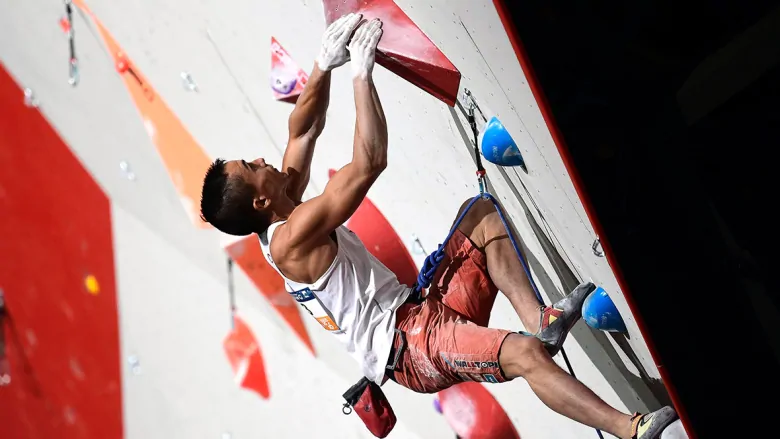The rock climbing olympics are here!
For the first time ever, climbers around the world can tune into the Olympic Games in 2020 and watch their favourite pastime right on the TV.
Making its debut alongside a host of other sports, such as baseball/softball, karate, skateboarding, and surfing at the Tokyo 2020 Olympic Games, sport climbing is poised to be a fan favorite amongst climbers and non-climbers alike.
Although we’re all excited to see rock climbing at on the world’s biggest athletics stage, we’ve all got some questions about exactly how the sport will play to at the Olympics.
To clear up any confusion and to dispel some of the rumors and myths that have been floating around, we’ve created this complete guide to climbing at the Olympics.
Here, we’ll talk more about how climbing came to be an Olympic event and what the format will look like at the games. We’ll discuss how qualifying works for such a unique sport and even give you some insight into the different teams and the favourites to take home the gold.
Let’s get to it!
How Did Finally Get Rock Climbing in the Olympics?
Although the Olympics have long been a focal point for athletes and fans of dozens of different sports, climbing has long been excluded from the Games’ hallowed halls.
Whether that was because climbing is often considered a “fringe” activity or because the general public had trouble picturing it as a sport, we’ll never know.
Ultimately, the decision to include climbing in the Olympics was based on the International Olympic Committee’s (IOC) desire to make the games relevant and appealing to a younger audience.
If you think that the inclusion of climbing at the upcoming summer Olympic Games is just a nice happenstance, think again: the International Federation of Sport Climbing (IFSC) has actually been advocating to get climbing into the Olympics for years.
The first time the sport was properly considered for a spot in the Olympics (after years and years of lobbying) was in 2013.
In 2013, the Executive Board (EB) of the IOC convened for a secret ballot, through which they’d announce which sports would be included in the 2020 Olympics.
Among those sports on the list were baseball/softball, squash, wrestling, karate, roller sports, wakeboarding, and, of course, climbing.
Unfortunately, this secret ballot didn’t end well from climbing’s perspective, as it was ultimately axed from the list of new sports for the 2020 Olympics.
This decision broke the hearts of many climbers the world over, who had hoped to show off their sport on a global stage. Luckily, climbing got a second bid for the 2020 games in 2015 when a new IOC reform was passed to allow the host city to add a sport or two to the line-up that already holds particular cultural meaning to the citizens of that country.
Eventually, Tokyo 2020 Committee and the IOC did, indeed, approve sport climbing as a new sport for the games.
Perhaps the popularity of the ice climbing demonstration at the Sochi 2014 games or the celebrity-status of Japan’s own Ashima Shiraishi played a role in climbing’s ultimate success, but at the end of the day, we’re all just excited to finally see the world’s best climbers competing for Olympic gold.
Now that we understand how climbing came to be an Olympic sport, let’s take a look at the format for the event at the Olympics and what it will take to qualify amongst an uber-talented pool of would-be Olympians.
The Climbing Olympics Format
If you thought that Olympic climbing would have the same format as other international sport climbing competitions, think again.
Unlike IFSC events, in which climbers compete for gold in one or more separate disciplines, including lead climbing, speed climbing, and bouldering, at the Olympics, athletes must compete in a vertical triathlon of sorts by taking part in all three disciplines.
Confused by the format? We were, too!
At the 2020 Tokyo Olympics, climbers will compete in sport climbing, bouldering, and speed climbing, and medals will be awarded based on a combined score from all three disciplines.
This is a huge step away from how medals are won in IFSC competitions, as climbers at those events only need to participate in the disciplines that they choose to compete in.
The speed climbing portion of the Olympics will involve two climbers racing against each other on a 15m high wall that’s set to a 95-degree angle.
Bouldering, on the other hand, will involve climbers attempting as many 4m high problems as they can within 4 minutes.
Finally, for the lead climbing, athletes will try to climb as high as they can before falling on a 15m high route within 6 minutes.
In the event of a tie in height for the lead climbing discipline, the fastest climber will prevail.
As you can imagine, the professional competition climbers of the world have, well, mixed reviews about this combined format.
Since most climbers focus solely on just one discipline (usually either lead climbing or bouldering), it’s pretty rare to find a climber that can boulder and lead at an exceptionally high level in competition.
Moreover, speed climbing is often considered as more of a fringe activity within climbing and is not widely practiced by many of the world’s top climbers.
Thus, finding a climber that can crush it at all three disciplines is no easy chore.
Although these multi-disciplinary climbing whizzes do exist (see Sean McColl), many climbers are concerned that this combination of disciplines will hamper the Olympic dreams of the vast majority of top climbers who specialise in just one type of climbing.
Additionally, many pros are concerned that they’ll have to give up their outdoor climbing time to spend more time pulling on plastic just to be competitive in an otherwise contrived competition.
Regardless of how you feel about the current format, however, many climbers are over the moon excited about seeing climbing in the Olympics for the first time.
Plus, even though climbing hasn’t even officially made its debut in the Olympics, there are already proposals in the works for the Paris 2024 Olympics, wherein lead and bouldering would become one event and speed climbing would be a separate discipline all on its own. Only time will tell, we suppose, but we’re excited to see where the sport will go from here.
Qualifying for the Olympics
Before anyone ever gets to compete in the Olympic Games, they need to qualify for their country’s Olympic team. Each sport has a predetermined limit on the maximum number of people and countries that can compete in each event, so only a select few countries ever get to compete in each sport in a given Olympic Games.
Although this may sound a bit harsh, the IOC argues that limiting the pool of athletes and countries is essential for maintaining a competitive atmosphere.
Thus, not all competition climbers on the international circuit will have the chance to climb at the Olympics.
Since climbing is an individual pursuit (at least in the competition world), it might be terribly clear as to how each country will go about selecting their climbers for the games. Here’s how it will work:
The first thing to understand about qualifying for the Olympics is that there will be a maximum of 20 men and 20 women competing at the 2020 Games.
Moreover, each country can only send a maximum of four climbers (two men and two women) to compete.
That being said, one men’s and one women’s spot is reserved for a Japanese competitor, as the host country is always guaranteed a qualifying spot in their own Games.
Finally, one men’s and one women’s spot will be reserved for selection by the Tripartite Commission, which is a committee that gives Olympic bids to athletes based on exceptional circumstances.
What all this means is that, in all actuality, there are only 18 men’s and 18 women’s spots up for grabs for the 2020 games. Therefore, only a select few climbers will be able to compete and only a small assortment of countries will be represented in the 2020 Games.
This will, of course, come as a disappointment to viewers from a number of countries that fail to qualify for the 2020 Olympics, but this is a process that plays out in every Olympic sport, so it’s not unique to climbing.
What is unique to climbing, however, is how athletes will be selected to compete in the Games.
Basically, climbers who want to qualify for the Olympics must participate (and win or place highly) at a number of Olympic Qualifying Events. At each of these events, Olympic invitations will be given to a predetermined number of the top placing athletes.
The first of Olympic Qualifying Event for climbing will take place at the IFSC Combined World Championships on August 20-21 in Hachioji, Japan. At this event, the top seven men and top seven women will be issued with official Olympic invitations, securing their spot to compete at the games.
That being said, since each country is only allowed two men and two women, if a large number of climbers from a given country place in the top seven for their gender, only the top two of those climbers will be given Olympic bids. Thus, if Canadian men take the top five spots in this event, only the top two of them will be invited.
Now, if you’ve been counting properly, you’ll know that by the end of this event, nine of the 20 Olympic spots for men and for women will have been snagged, since two spots for both men and women will be awarded to Tripartite and Japanese climbers.
This means, by the end of August 2019, only 22 more climber spots will be up for grabs for the 2020 Games.
The next Olympic Qualifying Event is in Toulouse, France on November 28 - December 1, 2019.
This event will only include the top 20 highest ranked climbers on the IFSC World Cup circuit, which means it’s in an athlete’s best interest to participate and excel in the 2019 World Cup season.
At the end of this event, the top six men and the top six women will be given Olympic invitations, leaving only 10 more climber spots available for last-minute bid attempts.
These last 10 Olympic bids will be given out to the winners of each of the five Continental Championships in the spring of 2020. This means that one spot will go to each man and each woman who takes home gold at these championships.
Here’s the catch: climbers may only compete in the Continental Championship that their home climbing federation is a membership of, so, for example, US climbers will compete in the Pan-American Continental Climbing Championship and British climbers will compete in the European Continental Climbing Championship.
The winner of each championship (one man and one woman) will secure their place at the Olympics, so long as they haven’t already qualified. In that case, the second place finisher (or the next as-of-yet unqualified competitor) will get an Olympic bid.
The dates and locations for each of the Continental Climbing Championships are as follows:
- Pan-American (Los Angeles, USA): February 27-March 1, 2020
- European (Moscow, Russia): April 16-18, 2020
- Oceania (Sydney, Australia): April 18-19, 2020
- Africa (Johannesburg, South Africa): May 1-3, 2020
- Asia (Morioka, Japan): May 18-24, 2020
Thus, by the end of May, the qualifying process will be done and each country’s roster will be relatively set in stone, barring any injuries or last-minute withdrawals. Should an athlete withdraw their bid, the Olympic invitation will go to the next highest ranking climber from whatever event the withdrawing climber earned their bid from.
If you’d like further details on the format, check out this document from the IFSC detailing the rule around selection and qualifying.
The teams
As we know now, each Olympic climbing team will be limited to a maximum of two men and two women from a given country. Thus, a country that qualifies for climbing can send as few as one individual climber to compete and as many as four. In theory, this means we could have as many as 39 different countries (taking into account Japan’s guaranteed one men’s and one women’s spots) competing in climbing at the 2020 Games.
Is this likely? Er.. not really. While there are certainly climbers from more than 39 different countries around the world, the top climbers in the overall World Cup rankings tend to come from a handful of powerhouse countries. Here are some that are likely to secure at least one climber spot in the Olympics:
- Japan (guaranteed)
- Canada
- Germany
- United States
- Great Britain
- Spain
- Russia
- Czech Republic
- Austria
But, as we know, when it comes to competition, anything can happen. So, we also recommend keeping an eye out for climbers from these countries:
- Brazil
- Switzerland
- Slovenia
- Slovakia
- China
- South Korea
- France
- Italy
- Belgium
- Poland
Only time will tell, of course, who manages to secure a spot in the Olympics. That being said, it’s important to consider how the format of the qualifying competitions will affect what countries gain an Olympic bid.
The first two competitions (the Olympic Qualifying Events in Japan and France) will likely result in bids being given to climbers from traditionally strong climbing countries, like the USA and Canada. However, since the last 10 qualifying spots are given to winners of each of the Five Continental Climbing Championships, we will also see climbers countries that don’t seem to churn out lots of World Cup winners, including those in Oceania and Africa.
Thus, as with everything in the Olympics, anything could happen from here. Come 2020, we’ll be excited to see what countries secure a spot in the Games and who takes home the first ever climbing gold.
Favourites to win gold
It’s actually quite difficult to determine who might be a favourite to win gold at the first-ever Olympic climbing event because of the somewhat unorthodox format of the games. While most competition climbers focus their training efforts on excelling at a particular discipline of climbing, the format of the Olympics means that the only climbers likely to succeed are those who can compete at a high level in lead, bouldering, and speed climbing.
Such all-rounder climbers are few and far between. As you might imagine, the unique format of the Olympics also means that many elite outdoor climbers are at a significant disadvantage unless they spend the next year focused almost solely on pulling plastic.
Although only a few outdoor climbers will be willing to do this, we can, perhaps, expect some top outdoor climbers to make the switch to indoor climbing, at least in the short term.
Climbing pundits have, however, started to identify favorites to win gold in 2020.
On the men’s side of things, Canadian Sean McColl is well poised to win it all.
As a true all-arounder, McColl has won the IFSC four times in the overall combined rankings and consistently excels in all three disciplines of competition climbing.
Adam Ondra, the world-renowned Czech outdoor climber that’s put up 5.15d routes and V16 boulder problems, has also been identified as a fan favorite to win, as he’s expected to shift his focus substantially toward training indoors in preparation for the Games.
For the women’s competition, Japan’s own Ashima Shiraishi seems exceptionally well positioned to take home the gold. The 17-year-old has been breaking records and pushing the limits both indoors and outside since she started climbing at just 6 years old.
Other potential champions from the women’s side of things include Brooke Raboutou of the United States, Petra Klingler of Switzerland, Janja Gambret of Slovenia, and Shauna Coxsey of Great Britain, though it’ll be interesting to see how each of these climbers fare in the unique format.




